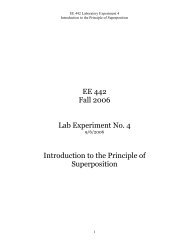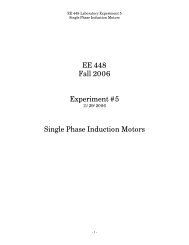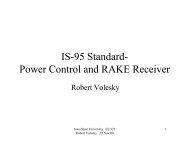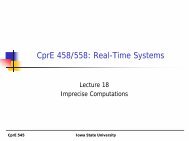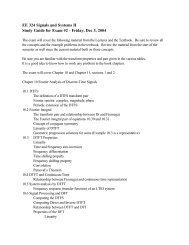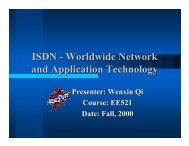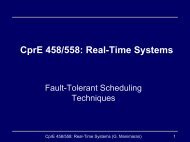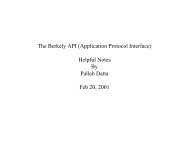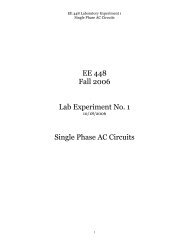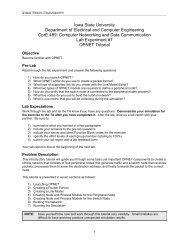Deterministic protocols for real-time communication in multiple ...
Deterministic protocols for real-time communication in multiple ...
Deterministic protocols for real-time communication in multiple ...
Create successful ePaper yourself
Turn your PDF publications into a flip-book with our unique Google optimized e-Paper software.
S. Norden et al. / Computer Communications 22 (1999) 128–136 131Table 1Node and channel status table (MDCR)Time N 1 N 2 N 3 N 40 (5, 17) (2, 6) (2, 9) (2, 12)1 C C C C2 N (5, 17)3 X (5, 17)4 X (5, 17) D (2, 6)5 X (5, 17)7 X (5, 17) D (2, 9)8 I I9 N (2, 12)10 X (2, 12)11respect to its predecessor, and modify<strong>in</strong>g the laxity of itssuccessor. Messages with negative laxity are removed fromthe queue.The LDCR protocol consists of three phases, namely,contention mode, collision resolution (CR) mode, andleast laxity first (LLF) mode, which are described below.This comb<strong>in</strong>ation of CR mode and LLF mode def<strong>in</strong>es anepoch <strong>in</strong> the LDCR protocol as contrasted to the DCR preorder and MDCR <strong>protocols</strong> where<strong>in</strong> an epoch is the CRmode alone.1. Contention mode (when channel is idle)(a) Each node exam<strong>in</strong>es the message at the head of itsqueue. If the laxity of the message is negative, themessage is dropped.(b) Otherwise, it attempts to transmit notifier <strong>for</strong> themessage.(c) If the notifier transmission is successful, themessage is transmitted.(d) If a collision occur dur<strong>in</strong>g notifier transmission, allnodes enter <strong>in</strong>to CR mode by travers<strong>in</strong>g the CR tree <strong>in</strong>pre order.Table 2Node and channel status table (LDCR). C: Collision; N: Notifier; X: Transmit;D: Drop; L: Laxity; I: IdleTime N 1 N 2 N 3 N 40 (5, 17) (2, 6) (2, 9) (2, 12)1 C C C C2 N (5, 17)3 Defer (L 1 ˆ 9) C C4 (L 1 ˆ 8) N (2, 6)5 (L 1 ˆ 7) X (2, 6)7 (L 1 ˆ 5) N (2, 9)8 X (2, 9)10 (L 1 ˆ 2) N (2, 12)11 X (2, 12)12 LLF mode – (L 1 ˆ 0): X (5, 17)172. Collision resolution mode(a) When a node n i gets its turn <strong>in</strong> the CR mode, ittransmits its notifier. Thus every other node is <strong>in</strong><strong>for</strong>medof the message requirements of node n i(b) If the laxity of a message (first message at queue ofn i ) is less than a threshold (but non-negative), then themessage is transmitted, else the message is deferred andper order traversal cont<strong>in</strong>ues. It two or more messageshave the laxity less than or equal to the threshold value,the preference is given to message with shorter service<strong>time</strong>. This m<strong>in</strong>imizes the <strong>time</strong> that the channel isblocked, thereby improv<strong>in</strong>g the chances of successfultransmission <strong>for</strong> subsequent messages.(c) Even after the CR tree is completely traversed, ifsome deferred messages are still to be transmitted, theprotocol enters <strong>in</strong>to the LLF mode.3. LLF mode(a) In the LLF mode, all the deferred messages aretransmitted, based on the least laxity order of messagesamong nodes. This phase is required to enable thosemessages, that arrived <strong>in</strong> the current epoch, to be transmittedbe<strong>for</strong>e the next epoch. By do<strong>in</strong>g this, the overhead<strong>in</strong>curred as result of collision between messages oftwo different epochs is elim<strong>in</strong>ated.(b) If all the messages are either transmitted or dropped,the next epoch beg<strong>in</strong>s.Note that the threshold value mentioned <strong>in</strong> Step 2(b) isfixed, <strong>in</strong> our protocol, to be one. The importance of thisvalue, is brought out <strong>in</strong> a subsequent section, when compar<strong>in</strong>gthis protocol with another representative protocol.3.4.2. Illustrative examplesIn this section, we demonstrate the effectiveness of theLDCR over MDCR with an illustrative example. The exampleconsiders a LAN with 4 nodes. Tables 1 and 2 depict thework<strong>in</strong>g of MDCR and LDCR, respectively. The first entry(at <strong>time</strong> 0) <strong>in</strong> these tables is the <strong>in</strong>itial status of the queue ateach node (each node has a s<strong>in</strong>gle message to transmit). Forexample, node N 1 has a message hav<strong>in</strong>g deadl<strong>in</strong>e of 17 andrequir<strong>in</strong>g 5 slots <strong>for</strong> transmission. In this example, the preorder traversal of CR tree (b<strong>in</strong>ary tree), as shown <strong>in</strong> Fig. 1, is<strong>in</strong> the order of N 1 ,N 2, N 3, and N 4.Let us trace a few steps <strong>in</strong> the MDCR protocol shown <strong>in</strong>Table 1. At <strong>time</strong> 1, all nodes attempt to transmit their notifierwhich results <strong>in</strong> collision, thus all nodes enter the CRmode. At <strong>time</strong> 2, N 1 (root of the CR tree) transmits itsnotifier, and proceeds to transmit its message from <strong>time</strong>slot 3 onwards, <strong>for</strong> 5 <strong>time</strong> slots. Thus all nodes back off<strong>for</strong> a period of 5 slots. Even though the laxity of thismessage is very large (10), compared to the laxity of othermessages, it is still transmitted. As result, the other nodes allend up hav<strong>in</strong>g negative laxity, when they get their turn. By<strong>time</strong> 8, two nodes <strong>in</strong> the left subtree (N 2 and N 3 ) would droptheir messages, as their laxities become negative at the end



